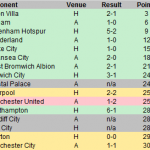Using Statistical Methods To Assess Relegation Odds
Which Premier League clubs will suffer relegation this season? Today Mark Taylor shows how statistical methods can help us assess relegation candidates as we head into the second half of the season.
January heralds the start of a new year and is also a convenient waypoint for the Premiership campaign. Just over half of the league matches have been played, so sides have played all of their rivals at least once, with the third round of the FA Cup proving either a pleasant or an unwelcome respite from the frenetic Christmas and New Year fixture list.
The upcoming transfer window also gives a final opportunity for teams to strengthen squads and foresighted chairman have usually already dispensed with the services of, what in their eyes have been substandard managerial appointments. For example, West Ham, alone of the current bottom five has retained the manager with which they started the 2025/14 season.
Unusually, the top of the Premiership is proving numerically more competitive than usual, where affluent sides such as Manchester City and Chelsea are engaged in close combat with older, established winners such as Arsenal and Liverpool. Whilst Manchester United's continued struggles to adapt to a new manager continues to amuse or frustrate, depending upon your allegiance.
Busy At The Bottom
However, it is the bottom of the table where the greatest team involvement always lies. 52 points is the average number of points gained by a Premiership side in the history of the 20 team league and with 40 points universally regarded as the pre-season target for survival, few sides outside of the elite can consider themselves safe, even with over half of the season elapsed.
The competitive balance throughout the Premiership over the years has made identifying the leaders and the strugglers a relatively simple task and the league positions occupied by sides once Premiership hostilities resume after the FA cup break offer a strong indicator of where a side will finish in May.
We can demonstrate the predictive quality of a January league position by testing the historical strength of the correlation between a side's league ranking now and their ultimate finishing position. If the league position of every side in January were to be repeated in May, the value of the correlation coefficient would be exactly one and while this obviously hasn't been the case historically, the average January to May coefficient is very nearly 0.9. By comparison, league positions after just five matches have coefficients of around 0.7 when compared to final finishing places.
So for the majority, a team's place in the pecking order becomes apparent relatively quickly, strengthens, and by January each side is going to finish relatively close to the position they occupied at the turning of the year.
Projecting Finishing













